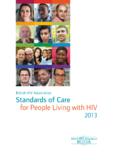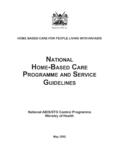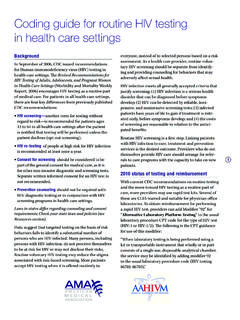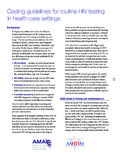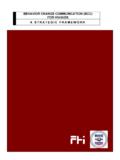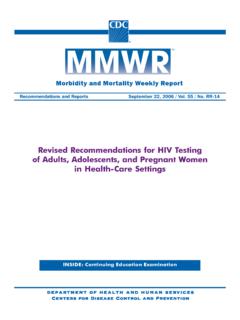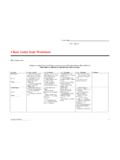Transcription of HIV/AIDS: A Guide For Nutrition, Care and Support
1 FANTA 2001 BROCHURE 9/19/01 3:02 PM Page 1. HIV/AIDS: A Guide For nutrition , care and Support July 2001. FANTA 2001 BROCHURE 9/19/01 3:02 PM Page 2. This Guide was made possible through Copies of the Guide can Support provided to the Food and be obtained from: nutrition Technical Assistance (FANTA). Project by the Office of Health and Food and nutrition Technical Assistance nutrition of the Bureau for Global (FANTA) Project Programs Field Support and Research at Academy for Educational Development the US Agency for International 1825 Connecticut Ave. NW, Development, under terms of Cooperative Washington DC, 20009-5721. Agreement No. HRN-A-00-98-00046-00 Tel: 202-884-8000. awarded to the Academy for Educational Fax: 202-884-8432. Development (AED). The opinions Email: expressed herein are those of the author Website: and do not necessarily reflect the views of the US Agency for International Development.
2 Recommended citation: HIV/AIDS: A Guide For nutrition , care and Support . Food and nutrition Technical Assistance Project, Academy for Educational Development, Washington DC, 2001. Published September 2001. FANTA 2001 BROCHURE 9/19/01 3:02 PM Page 3. Contents Page number 7 INTRODUCTION. 7 Purpose 8 Audience 8 How To Use This Guide 1. MODULE 1. 10 nutrition and HIV/AIDS: Basic Facts 10 What is HIV? What is AIDS? 11 How HIV Is Transmitted 11 How HIV Is NOT Transmitted 12 HIV Cases in Africa 12 nutrition and HIV/AIDS. 13 Anorexia 13 Diarrhea 13 Fever 14 Nausea/Frequent Vomiting 14 Thrush 14 Anemia 14 Other Nutritional Impacts of HIV. 15 How to Maintain Good nutrition 15 Macronutrients 15 Micronutrients 16 References FANTA 2001 BROCHURE 9/19/01 3:02 PM Page 4.
3 Contents - continued MODULE 2. 18 Coping with HIV: nutrition and Other Strategies for Living Positively 18 Good Nutritional Practices 18 Eat Small but Frequent Meals 18 Eat a Variety of Foods 21 Growth Promotion and Preventive Health care for Children 21 Safe Hygienic Practices: Proper Storage and Handling of Food and Water 21 Water 21 Animal Products 21 Fruits and Vegetables 21 General Foods Storage and Handling 22 Safer Sexual and Reproductive Health Practices 22 Physical Activity 22 Immediate Attention for Illnesses 22 Eating During and After Illness 23 Psychosocial Support 23 Involvement in Community Activities 23 References 2. MODULE 3. 3. FOOD MANAGEMENT FOR ADULTS LIVING WITH AIDS-RELATED. 24 SYMPTOMS AND ILLNESSES. 27 Planning Meals for PLWHAs 28 Nutritional Counseling and Support 29 References FANTA 2001 BROCHURE 9/19/01 3:02 PM Page 5.
4 MODULE 4. Nutritional Issues Associated with Modern 30 and Traditional Therapies 31 Modern Medications 31 Traditional Therapies 33 Diarrhea 33 Fever 34 Cough 34 Headaches 34 Sore Throats 35 Sores in the Mouth and Thrush 35 Shingles 35 Other Skin Rashes 36 References 4. MODULE 5. 37 nutrition and care Recommendations for Infants/Children 38 Messages for Health Workers and Promoters Working with Mothers Whose Status is Unknown or HIV-Negative 41 Recommendations for Health Workers and Promoters Working with HIV-Infected Mothers 42 References 5. MODULE 6. 43 A Food-Based Approach to Support HIV/AIDS Affected Households and Communities 43 Introduction 44 Community-Based care and Support 44 Facilitating a Community-Led Situation Assessment 44 Designing and Implementing a Food Program 48 Selecting Ration Size and Composition 51 Linking Communities with Other Services 54 Institution-Based Feeding Programs 54 Institutional care for Severely Malnourished Individuals 55 References 6.
5 FANTA 2001 BROCHURE 9/19/01 3:02 PM Page 6. Acknowledgements Serena Rajabiun was the principal author. Many people and organizations contributed to this Guide . An early draft of the Guide was reviewed by organizations in Malawi, Uganda and Zimbabwe. These organizations included: Malawi- Catholic Relief Services, Lighthouse Clinic, NAPHAM, Network for People Living with HIV/AIDS, US Peace Corps/Agricultural Research Center and Save the Children; Uganda- The AIDS Support Organization, Catholic Relief Services and The Regional Quality of care Center; Zimbabwe- Catholic Relief Services, The Mutare Catholic Health Services. Additional technical input was provided by: Bruce Cogill, Tony Castleman, Paige Harrigan, Marya Khan, Sandra Remancus, Anne Swindale and Caroline Tanner (Food and nutrition Technical Assistance Project); Rene Berger, Paurvi Bhatt, Eunyong Chung, Paul Delay, Miriam Labbok, Joan LaRosa, Linda Sussman and John Williamson (USAID); Dorcas Lwanga, Micheline Ntiru and Ellen Piwoz (SARA/SANA Project, AED); Mary Kroeger and Jay Ross (Linkages Project, AED); Leslie Elder (World Bank).
6 FANTA 2001 BROCHURE 9/19/01 3:02 PM Page 7. Introduction A. pproximately 36 million persons are living with HIV/AIDS. worldwide, 25 million of them in Africa. This Guide provides information for affected households and communities on how to live a healthy life from the time of infection with HIV through the progression of the disease. Because a majority of people may not know their HIV status, the food/diet messages included are appropriate to help all adults and children lead healthier, more productive lives. The Guide does not cover drug treatment and preventive practices, but complements other references on this topic. Purpose This Guide is intended to help development program managers make recommendations on food management and nutritional issues for households with members who are HIV-infected or living with AIDS.
7 The information focuses on dietary and care practices for adults during different stages of HIV. and also provides suggestions for all household and community members coping with the infection and trying to maintain their health and nutritional status. The Guide refers to the nutritional care and Support needs of individuals infected with HIV; that is, they have the virus with or without signs of AIDS. The Guide is also designed for individuals, families and communities affected by HIV; that is, they may or may not be HIV-infected but are experiencing the social, economic and often health consequences of the virus. The Guide is designed with the view that sound nutrition practices will benefit both infected and affected populations. Since little research is available on nutritional interventions for HIV-infected children, the Guide provides general recommendations for improving their 7.
8 FANTA 2001 BROCHURE 9/19/01 3:02 PM Page 8. nutritional status. Feeding recommendations for both adults and children include using locally available food products, balancing food and nutrition with medications and selecting appropriate foods through external donation programs (such as US Title II1 and the World Food Program). Audience Program managers and technical staff working with food aid and food security programs in HIV-affected areas who seek to design programs to meet the dietary needs of households coping with infection;. Community-based organizations working with care and Support issues for HIV-affected households who need information on appropriate food and nutrition practices;. Institutions caring for persons living with HIV/AIDS or for children who have lost one or more parents/guardians to HIV/AIDS; and District health leaders and community and health workers in areas affected by HIV who are assessing the needs of their communities and targeting resources to those needs.
9 How To Use This Guide The Guide highlights thematic issues related to HIV/AIDS and nutrition . The six modules are organized to allow program managers to select the issues most relevant to their programs and incorporate the information as needed. In addition, the modules can be translated and adapted and shared with communities and households as a reminder of the simple practices necessary to maintain a healthy lifestyle. The six modules are: Module 1: nutrition and HIV/AIDS: Basic Facts This module provides basic information on HIV/AIDS, the relationship between HIV/AIDS and nutrition and basic elements of good nutrition . Module 2: Coping With HIV: nutrition and Other Strategies For Living Positively This module provides guidelines for helping HIV-infected adults who are not showing signs of illness maintain good nutrition and health status.
10 1. The United States Title II Program is managed by the US Agency for International Development (USAID) Bureau for Humitarian Response, Office of Food for Peace. Private voluntary organizations and nongovernmental organizations can solicit requests for donated US food commodities to use in their development programs. For information, contact USAID's Bureau for Humanitarian Response at 8. FANTA 2001 BROCHURE 9/19/01 3:02 PM Page 9. I N T RO D U C T I O N. Module 3: Food Management For Adults Living With AIDS-Related Symptoms and Illnesses This module provides dietary recommendations for adults who are coping with AIDS-related symptoms and illnesses. Module 4: Nutritional Issues Associated With Modern and Traditional Therapies This module describes the nutritional issues associated with therapies to treat HIV-related illnesses and symptoms.










